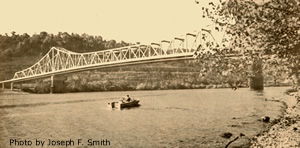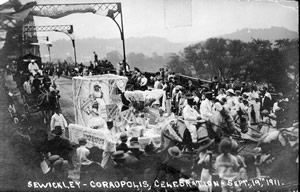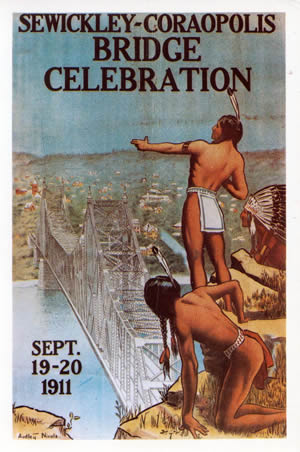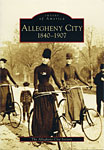The Sewickley Bridge
The most visible symbol of Sewickley, Pennsylvania, is a bridge over the Ohio River. Since 1911, people have gained access to the south side of the river by means of a bridge on the same spot.

However, what is visible to the eye today as traffic travels from Sewickley to Coraopolis and Moon Township, and to the Greater Pittsburgh Airport beyond, is not the original span. Worn out by an increasing heavier load of traffic and weathered by successively rugged winters in the late 1970s, Sewickley Bridge I was closed to traffic permanently on May 14, 1980.
As inconvenient as the 17-month downtime between the earlier span and its replacement was, there was cause for rejoicing that a new bridge would ensure a quick way to the other side well into the 21st century.
There was also a feeling of pride on the part of the citizenry in having secured, against bureaucratic resistance, the promise of a replacement span. The Committee to Save the Sewickley Bridge had done its work well in persistently charting a course through layers of government on the county, state and federal levels to secure funding of $16.4 million for the new structure.
Chairman of the Committee to Save the Sewickley Bridge was John R. Simpson of Sewickley. Spearheading the campaign through the bureaucratic maze was Gloria G. Berry of Edgeworth. Marvin M. Wedeen, vice chairman of CSSB, was a charter organizer.
Dismantling of the old structure and construction of the new was completed by U.S. Steel's American Bridge Division, Ambridge, Pa.
Designer was Richardson, Gordon & Associates, Pittsburgh; general contractor and steel erector: American Bridge Division, U.S. Steel Corp., Pittsburgh; steel fabricator was U.S. Steel Fabrication, Ambridge.

The new bridge opened on October 21, 1981, with Governor of Pennsylvania Richard L. Thornburgh presiding over the ceremony. Citizens from Sewickley, Coraopolis and surrounding communities cheered as the ribbon was cut on a brilliant fall day.
The new bridge, like the old, is 1,850 feet long. It includes two, 12-foot-wide lanes with four-foot shoulders and a five-foot pedestrian walkway. The piers of Bridge I were capped and modified for the wider, new span.
Sewickley Bridge II was named 1982 Prize Bridge (Long Span Category) by the American Institute of Steel Construction. It was the last span to be built by U. S. Steel's American Bridge Division.
In dismantling the 68-year-old original structure, American Bridge lowered the 350-foot long center span in one section on July 9, 1980. With spectators present on both sides of the river, the center was lowered with blocks and wire rope by means of two large hoists placed on the bridge deck, one near each of the two river piers.
American Bridge installed two falsework bents (temporary supports) to balance the bridge once the center span was removed. The bents, one on each side, could be jacked up to relieve the load on the pier at the end of the bridge truss as demolition progressed.
Like its successor, Sewickley Bridge I was a prizewinner of sorts, recognized in The World Almanac and Book of Facts as one of the ten outstanding cantilever spans in the United States. It, too, had been a citizens' effort.
On November 24, 1894, the first impetus for a free bridge over the Ohio River between Sewickley and Coraopolis was manifested at a public meeting. Ezra P. Young was appointed chairman; Gilbert A. Hays, secretary. Public subscriptions were collected.

A petition was presented to Judge J. W. F. White of the Allegheny County Common Pleas Court, after which viewers were appointed to meet at the proposed site on July 16, 1895. Approval came later the same year on December 17.
Government engineers were appointed by the Honorable William H. Taft, then Secretary of War, on June 28, 1907. A building permit for the great structure was issued by Secretary Taft on February 6, 1908. This gave unanimous assurance that the United States War Department, which had held the matter up, now approved of construction.
The contract was awarded to the Adam Laidlaw Company for the masonry work on July 2, 1909. Cost was $98,907. On the same day, Fort Pitt Bridge Co. was awarded the contract for the superstructure at $372,400. Time limit for completion was set for November 30, 1910. County engineer was J. G Chalfant.
Groundbreaking ceremonies took place-on both sides of the river on July 21, 1909. The bridge was formally opened and dedicated to public use September 19, 1911. It was followed from September 20-23 by the grandest celebration in the history of Sewickley.
A poster especially designed for the bridge opening was commissioned from Sewickley artist Audley Nicols (1875-1941). The popularity of the poster design, featuring three Indians marveling over the new span from the Coraopolis side, became a symbol of the town of Sewickley. It is also used as the motif of the Sewickley Valley Historical Society.
B. G. Y. S.

